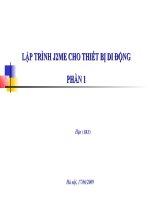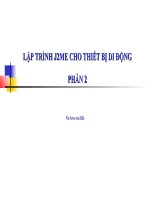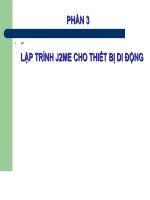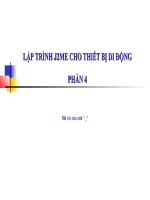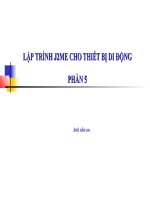Lập trình J2ME cho thiết bị di động - 04 - Ebook
Bạn đang xem bản rút gọn của tài liệu. Xem và tải ngay bản đầy đủ của tài liệu tại đây (508.89 KB, 30 trang )
LẬP TRÌNH J2ME CHO THIẾT BỊ DI ĐỘNG
LẬP TRÌNH J2ME CHO THIẾT BỊ DI ĐỘNG
PHẦN 4
PHẦN 4
Bãi rác của anh ^_^
2
5. Record Management System (RMS)
5. Record Management System (RMS)
MIDP không sử dụng hệ thống file để lưu trữ dữ liệu. Thay vào đó MIDP lưu toàn bộ thông tin
vào non-volatile memory (dung lượng vùng nhớ) bằng hệ thống lưu trữ gọi là Record
Management System (RMS).
RMS là hệ thống được tổ chức và quản lý dưới dạng các record (bản ghi). Mỗi bản ghi có thể
chứa bất kỳ loại dữ liệu nào:kiểu số nguyên, chuỗi ký tự, một ảnh và kết quả của một Record là
một chuỗi (mảng) các byte. Nếu bạn mã hoá dữ liệu của bạn dưới dạng nhị phân (binary), bạn có
thể lưu trữ dữ liệu bằng Record sau đó đọc dữ liệu từ Record và khôi phục lại dữ liệu ban đầu.
Kích thước dữ liệu không được vuợt quá giới hạn qui định của thiết bị di động. RMS lưu dữ liệu
gần như một cơ sở dữ liệu, bao gồm nhiều dòng, mỗi dòng lại có một số định danh duy nhất.
Một tập các bản ghi(RecordStore) là tập hợp các Record được sắp xếp có thứ tự. Mỗi Record
không thể đứng độc lập mà nó phải thuộc vào một RecordStore nào đó, các thao tác trên Record
phải thông qua RecordStore chứa nó. Khi tạo ra một Record trong RecordStore, Record được
gán một số định danh kiểu số nguyên gọi là Record ID. Record đầu tiên được tạo ra sẽ được gán
Record ID là 1,sẽ tăng thêm 1 cho các Record tiếp theo. Record ID không là chỉ mục (index), các
thao tác xóa Record trong RecordStore sẽ không tính toán lại các Record ID của các Record hiện
có cũng không thay đổi Record ID của các Record được tạo mới, ví dụ: xóa record id 3, thêm
một record mới sẽ có id là 4. Data là một dãy các byte đại diện cho dữ liệu cần lưu.
Tên được dung để phân biệt các RecordStore trong bộ các MIDlet (MIDlet suite). MIDlet suite
là tập các MIDlet có chung không gian tên (name space), chia sẻ cùng tài nguyên (như
RecordStore), các biến tĩnh (static variable) trong các lớp và các MIDlet này sẽ được đóng gói
trong cùng một file khi triển khai. Nếu ứng dụng của bạn chỉ có một MIDlet thì các RecordStore
được sử dụng cũng phân biệt lẫn nhau bằng các tên. Tên của RecordStore có thể dài đến 32 ký tự
Unicode và là duy nhất trong một MIDlet suite.
3
Các vấn đề liên quan đến RMS
Các vấn đề liên quan đến RMS
Hạn chế về khả năng lưu trữ của thiết bị di động : Dung lượng vùng nhớ (non-
volatile memory) dành riêng cho việc lưu trữ dữ liệu trong RMS thay đổi tùy theo
thiết bị di động. Đặc tả MIDP yêu cầu rằng các nhà sản xuất thiết bị di động phải
dành ra vùng nhớ có kích thước ít nhất 8K cho việc lưu trữ dữ liệu trong RMS. Đặc
tả không nêu giới hạn trên cho mỗi Record. RMS cung cấp các API để xác định kích
thước của mỗi Record, tổng dung lượng của RecordStore và kích thước còn lại của
vùng nhớ này. Do đó trong quá trình phát triển các ứng dụng J2ME bạn phải cân
nhắc trong việc sử dụng vùng nhớ này.
Tốc độ truy xuất dữ liệu :Các thao tác trên vùng nhớ này sẽ chậm hơn nhiều khi
truy xuất dữ liệu trên bộ nhớ RAM. Giống như tốc độ đọc ổ cứng và tốc độ đọc từ
RAM của máy tính. Trong kỹ thuật lập trình phải thường xuyên cache dữ liệu và các
thao tác liên quan đến RMS chỉ thực hiện tập trung một lần (lúc khởi động hay đóng
ứng dụng).
Cơ chế luồng an toàn :Nếu RecordStore chỉ được sử dụng bởi một MIDlet, không
phải lo lắng vì RMS sẽ dành riêng một Thread để thực hiện các thao tác trên
RecordStore. Tuy nhiên nếu có nhiều MIDlet và Thread cùng chia sẻ một
RecordStore thì phải chú ý đến kỹ thuật lập trình Thread để đảm bảo không có sự
xung đột dữ liệu
4
Các hàm API trong RMS (1)
Các hàm API trong RMS (1)
RecordStore không có hàm khởi tạo.
RecordStore Class: javax.microedition.rms.RecordStore
static RecordStore openRecordStore(String recordStoreName, boolean createIfNecessary) : Mở
một Recordstore, có tham số tạo Record store nếu nó chưa tồn tại.
Ví dụ: chỉ duy nhất 1 đối tượng RecordStore được tạo mặc dù mở nhiều lần cùng 1 tên
private RecordStore rs = null;
static final String REC_STORE = "db_1";
private void db(String str) {
System.err.println("Msg: " + str);
} }
public void openRecStore() {
try {
// Create record store if it does not exist
rs = RecordStore.openRecordStore(REC_STORE, true );
}
catch (Exception e) {
db(e.toString());
} }
Với tham số true, hàm sẽ tạo một RecordStore nếu nó chưa tồn tại.
5
Các hàm API trong RMS (2)
Các hàm API trong RMS (2)
void closeRecordStore() : Đóng RecordStore
Ví dụ:
private RecordStore rs = null;
public void closeRecStore() {
try{
rs.closeRecordStore();
}
catch (Exception e) {
db(e.toString());
} }
static void deleteRecordStore(String recordStoreName) : Xóa RecordStore
static String[] listRecordStores() : Danh sách các RecordStore trong MIDlet suite, trả về mảng
các chuỗi là tên của RecordStore, nếu không có RecordStore nào thì trả về null
Ví dụ:
public void deleteRecStore() {
if (RecordStore.listRecordStores() != null){
try {
RecordStore.deleteRecordStore(REC_STORE);
}
catch (Exception e) {
db(e.toString());
}
}}
6
Các hàm API trong RMS (3)
Các hàm API trong RMS (3)
int addRecord(byte[] data, int offset, int numBytes):Thêm một record vào
RecordStore
Ví dụ:
public void writeRecord(String str) {
byte[] rec = str.getBytes();
try {
rs.addRecord(rec, 0, rec.length);
}
catch (Exception e) {
db(e.toString());
} }
Trước khi lưu vào RecordStore, cần phải chuyển đổi kiểu string thành dãy byte
byte[] rec = str.getBytes(); rs.addRecord(rec, 0, rec.length);
Có thể thêm một Record rỗng vào RecordStore nếu tham số đầu tiên là null. Tham số
thứ 2 cho biết vị trí bắt đầu trong mảng các byte và tham số thứ 3 cho biết số byte sẽ
được ghi vào RecordStore. Nếu thực hiện thành công, phương thức này trả về số
nguyên chỉ số recordID của Record vừa được thêm vào.
7
Các hàm API trong RMS (4)
Các hàm API trong RMS (4)
int getRecord(int recordId, byte[] buffer, int offset) : Lấy nội dung của record vào
dãy byte.
int getNumRecords() : Số lượng các record.
Ví dụ:
public void readRecords() {
try {
byte[] recData = new byte[50];
int len;
for (int i = 1; i <= rs.getNumRecords(); i++){
len = rs.getRecord( i, recData, 0 );
System.out.println("Record #" + i + ": " +new String(recData, 0, len));
System.out.println(" ");
}
}
catch (Exception e) {
db(e.toString());
}
}
8
Các hàm API trong RMS (5)
Các hàm API trong RMS (5)
Trong ví dụ trên do biết trước kích thước của string nên khai báo dãy byte vừa đủ, trong thực tế
ta nên kiểm tra kích thước của record để khai báo dãy byte cần thiết để tránh phát sinh lỗi, do đó
hàm ReadRecord có thể sửa lại như sau:
public void readRecords() {
try {
int len;
for (int i = 1; i <= rs.getNumRecords(); i++) {
if (rs.getRecordSize(i) > recData.length)
recData = new byte[rs.getRecordSize(i)];
len = rs.getRecord(i, recData, 0);
System.out.println("Record #" + i + ": " +
new String(recData, 0, len));
System.out.println(" ");
}
}
catch (Exception e) {
db(e.toString());
}
}
9
Ví dụ : đọc và ghi đối tượng string (ReadWrite.java) (1)
Ví dụ : đọc và ghi đối tượng string (ReadWrite.java) (1)
import java.io.*;
import javax.microedition.midlet.*;
import javax.microedition.rms.*;
public class ReadWrite extends MIDlet {
private RecordStore rs = null;
static final String REC_STORE = "db_1";
public ReadWrite() {
openRecStore(); // tạo record store
// viết vào record và đọc chúng ra
writeRecord("J2ME and MIDP");
writeRecord("Wireless Technology");
readRecords();
closeRecStore(); // đóng record store
deleteRecStore(); // Xoá record store
}
public void destroyApp( boolean unconditional ){}
public void startApp() {
// There is no user interface, go ahead and shutdown
destroyApp(false);
notifyDestroyed();
}
public void pauseApp(){ }
10
Ví dụ : đọc và ghi đối tượng string (ReadWrite.java) (2)
Ví dụ : đọc và ghi đối tượng string (ReadWrite.java) (2)
public void openRecStore() {
try { // Create record store if it does not exist
rs = RecordStore.openRecordStore(REC_STORE, true );
}
catch (Exception e) {
db(e.toString());
} }
public void closeRecStore() {
try {
rs.closeRecordStore();
}
catch (Exception e) {
db(e.toString());
} }
public void deleteRecStore() {
if (RecordStore.listRecordStores() != null) {
try {
RecordStore.deleteRecordStore(REC_STORE);
}
catch (Exception e) {
db(e.toString());
} } }
public void writeRecord(String str) {
byte[] rec = str.getBytes();
try {
rs.addRecord(rec, 0, rec.length);
}
catch (Exception e) {
db(e.toString());
} }
11
Ví dụ : đọc và ghi đối tượng string (ReadWrite.java) (3)
Ví dụ : đọc và ghi đối tượng string (ReadWrite.java) (3)
public void readRecords() {
try {
byte[] recData = new byte[50];
int len;
for (int i = 1; i <= rs.getNumRecords(); i++)
{
len = rs.getRecord( i, recData, 0 );
System.out.println("Record #" + i + ": " +
new String(recData, 0, len));
System.out.println(" ");
}
}
catch (Exception e) {
db(e.toString());
}
}
private void db(String str){
System.err.println("Msg: " + str);
}
}
Thực hiện:
ReadWrite
ReadWrite
12
Chuyển đổi dữ liệu giữa Record và Mảng các byte (1)
Chuyển đổi dữ liệu giữa Record và Mảng các byte (1)
Dữ liệu được RMS lưu trữ trong các Record là một chuỗi (mảng) các byte. Trong ứng dụng, bạn
muốn lưu trữ nhiều kiểu dữ liệu khác nhau: một số nguyên hay là chuỗi các ký tự.Vậy trước khi
lưu dữ liệu vào Record cần phải chuyển dữ liệu này thành mảng các byte. Vấn đề là phải tìm ra
các đối tượng trung gian giúp việc lưu trữ dữ liệu vào Record và đọc dữ liệu từ các Record một
cách dễ dàng, thuận tiện và hiệu quả. CLDC cung cấp các lớp: java.io.ByteArrayInputStream,
java.io.ByteArrayOutputStream, java.io.DataInputStream, java.io.DataOutputStream được thừa
hưởng từ J2SE dễ dàng trong việc chuyển đổi dữ liệu qua lại giữa RMS và ứng dụng trong gói
java.io.
Lớp java.io.ByteArrayInputStream chuyển đổi một mảng các byte thành một luồng vào(input
stream), và cung cấp các phương thức thao tác dữ liệu trên nó một cách dễ dàng. Ví dụ đọc và in
ra tất cả các giá trị trong mảng các byte.
byte[] data = new byte[]{ 1, 2, 3 };
ByteArrayInputStream bin = new ByteArrayInputStream( data );
int b;
while( ( b = bin.read() ) != -1 ){
System.out.println( b );
}
try {
bin.close();
} catch( IOException e ){}
13
Chuyển đổi dữ liệu giữa Record và Mảng các byte (2)
Chuyển đổi dữ liệu giữa Record và Mảng các byte (2)
Lớp java.io.ByteArrayOutputStream :ghi dữ liệu kiểu byte lên mảng các byte. Ví dụ
ghi vào ByteArrayOutStream ba giá trị 1, 2, 3 liên tiếp sau đó xuất ra mảng các byte.
ByteArrayOutputStream bout = new ByteArrayOutputStream();
bout.write( 1 ); bout.write( 2 ); bout.write( 3 );
byte[] data = bout.toByteArray();
for( int i = 0; i < data.length; ++i ){
System.out.println( data[i] );
}
try {
bout.close();
} catch( IOException e ){
// bỏ qua các ngọai lệ
}
Bộ đệm (buffer) của ByteArrayOutStream sẽ tự động tăng dần lên khi ghi dữ liệu lên
nó, phương thức toByteArray() của nó sẽ chép tất cả dữ liệu lên mảng các byte.
14
Ghi dữ liệu kiểu cơ bản trên Record
Ghi dữ liệu kiểu cơ bản trên Record
Ghi dữ liệu có các kiểu cơ bản như int, long, String lên một Record thực hiện bằng các lớp
java.io.ByteArrayOutputStream và java.io.DataOutputStream.
private RecordStore rs = null;
public void writeStream(String[] sData, boolean[] bData, int[] iData) {
try {// Write data into an internal byte array
ByteArrayOutputStream strmBytes = new ByteArrayOutputStream();
DataOutputStream strmDataType = new DataOutputStream(strmBytes);
byte[] record;
for (int i = 0; i < sData.length; i++) { // Write Java data types
strmDataType.writeUTF(sData[i]); strmDataType.writeBoolean(bData[i]);
strmDataType.writeInt(iData[i]); strmDataType.flush(); // Clear any buffered data
record = strmBytes.toByteArray(); // Get stream data into byte array and write record
rs.addRecord(record, 0, record.length);
strmBytes.reset(); }
strmBytes.close(); strmDataType.close(); }
catch (Exception e) {
db(e.toString()); } }
15
Đọc dữ liệu kiểu cơ bản trên Record
Đọc dữ liệu kiểu cơ bản trên Record
Đọc dữ liệu từ Record ngược lại bằng các lớp java.io.ByteArrayInputStream và
java.io.DataInputStream.
public void readStream() {
try {
// Careful: Make sure this is big enough!Better yet, test and reallocate if necessary
byte[] recData = new byte[50]; // Read from the specified byte array
ByteArrayInputStream strmBytes = new ByteArrayInputStream(recData);
// Read Java data types from the above byte array
DataInputStream strmDataType = new DataInputStream(strmBytes);
for (int i = 1; i <= rs.getNumRecords(); i++){ // Get data into the byte array
rs.getRecord(i, recData, 0); // Read back the data types
System.out.println("Record #" + i);
System.out.println("UTF: " + strmDataType.readUTF());
System.out.println("Boolean: " +strmDataType.readBoolean());
System.out.println("Int: " + strmDataType.readInt());
System.out.println(" ");
strmBytes.reset(); // Reset so read starts at beginning of array
}
strmBytes.close();
strmDataType.close();
}
catch (Exception e){
db(e.toString());
} }
16
Ghi và đọc sử dụng stream
Ghi và đọc sử dụng stream
Quá trình ghi dữ liệu vào RecordStore được thực hiện thông qua các bước:
• Cấp phát stream.
• Ghi dữ liệu vào stream.
• Flush stream.
• Chuyển đổi stream data thành mảng byte.
• Ghi mảng byte vào RecordStore.
• Đóng stream.
Khi sử dụng DataOutputStream và DataInputStream, cần phải đọc và ghi theo đúng
thứ tự, nếu không sẽ không ra kết quả mong muốn
Ví dụ:
ReadWriteStreams
ReadWriteStreams
17
Duyệt Record với RecordEnumeration
Duyệt Record với RecordEnumeration
Lớp này cung cấp các phương thức để duyệt các record trong RecordStore một cách nhanh
chóng. Dưới đây là đoạn code duyệt toàn bộ RecordStore:
RecordEnumeration re = rs.enumerateRecords(null,null,false);
while (re.hasNextElement()) { // Get the next record into a String
String str = new String(re.nextRecord());
}
RecordEnumeration Interface: javax.microedition.rms.RecordEnumeration
int numRecords() : Số lượng record trong enumeration
byte[] nextRecord(): Record tiếp theo
int nextRecordId() : Record ID của record tiếp theo
byte[] previousRecord(): Record trước đó
int previousRecordId() : Record ID của record trước đó
boolean hasNextElement() : Kiểm tra enumeration có record kế tiếp
boolean hasPreviousElement() : Kiểm tra enumeration có record trước đó
void keepUpdated(boolean keepUpdated): Đặt enumeration reindex sau khi co sự thay đổi
boolean isKeptUpdated() : Kiểm tra enumeration có tự động reindex()
void rebuild() : Tạo lại index
void reset() : Đưa enumeration về record đầu tiên
void destroy() : Giải phóng tài nguyên được sử dụng bởi enumeration
18
Sắp xếp các record với interface RecordComparator (1)
Sắp xếp các record với interface RecordComparator (1)
Interface định nghĩa phương thức compare với trị đầu là hai mảng các byte thể hiện
hai Record cần so sánh. Phương thức này trả về các trị được định nghĩa trong
interface:
•EQUIVALENT: Nếu hai Record bằng nhau
•FOLLOWS: Nếu Record thứ 1 đứng sau Record thứ 2
•PRECEDES: Nếu Record thứ 1 đứng trước Record thứ 2
Do RecordComparator là một interface nên khi sử dụng cần phải implements nó:
public class Comparator implements RecordComparator {
public int compare(byte[] rec1, byte[] rec2){
String str1 = new String(rec1), str2 = new String(rec2);
int result = str1.compareTo(str2);
if (result == 0)
return RecordComparator.EQUIVALENT;
else if (result < 0)
return RecordComparator.PRECEDES;
else
return RecordComparator.FOLLOWS;
}
}
19
Sắp xếp các record với interface RecordComparator (2)
Sắp xếp các record với interface RecordComparator (2)
Trong hàm readRecord(), khi tạo Enumeration ta đã tham chiếu đến đối tượng comp của lớp
Comparator, khi enumerator tạo index cho RecordStore nó sẽ sử dụng hàm compare() ở trên để
sắp xếp các record (record là dạng text - hàm String.CompareTo() )
public void readRecords() {
try {
if (rs.getNumRecords() > 0){
Comparator comp = new Comparator();
RecordEnumeration re = rs.enumerateRecords(null, comp, false);
while (re.hasNextElement()) {
// Calls String constructor that takes an array of bytes as input
String str = new String(re.nextRecord());
System.out.println(str);
System.out.println(" ");
}}}
catch (Exception e){
db(e.toString());
}}
Ví dụ:
SimpleSort
SimpleSort
20
Sắp xếp các record với dữ liệu kiểu cơ bản
Sắp xếp các record với dữ liệu kiểu cơ bản
Nếu ghi nhiều kiểu dữ liệu vào trong một record:
strmDataType.writeUTF("Text 1");
strmDataType.writeBoolean(true);
strmDataType.writeInt(1);
Các kiểu dữ liệu sẽ lưu vào một stream dạng binary. Các stream này được chuyển thành mảng và
đưa vào recordstore: record = strmBytes.toByteArray();
rs.addRecord(record, 0, record.length);
Với kiểu dữ liệu binary ta phải viết lại hàm compare() thự c hiện chức năng chuyển đổi chuỗi
byte và sắp xếp đúng kiểu dữ liệu. Thực thi interface RecordComparator để sắp xếp record chứa
nhiều kiểu dữ liệu. Đây là dữ liệu sẽ lưu vào recordstore:
String[] names = {"Thu", "Hanh", "Yen", "Khanh","Anh"};
boolean[] sex = {false,true, false, true,true};
int[] rank = {2, 0, 4, 3,1};
Khi lưu vào recordstore sẽ có dạng như sau:
Record #1
Name : Anh
Sex : Male
Rank : 1
21
Sắp xếp các record với dữ liệu kiểu String (1)
Sắp xếp các record với dữ liệu kiểu String (1)
public void readStream() {
try {
byte[] recData = new byte[50];
ByteArrayInputStream strmBytes = new ByteArrayInputStream(recData);
DataInputStream strmDataType = new DataInputStream(strmBytes);
if (rs.getNumRecords() > 0) {
ComparatorString comp = new ComparatorString(); int i = 1;
RecordEnumeration re = rs.enumerateRecords(null,comp, false);
while (re.hasNextElement()){
rs.getRecord(re.nextRecordId(), recData, 0);
System.out.println("Record #" + i++);
System.out.println("Name: " + strmDataType.readUTF());
if (strmDataType.readBoolean())
System.out.println("Sex: Male");
else
System.out.println("Sex: Female" );
System.out.println("Rank: " + strmDataType.readInt());
System.out.println(" ");
strmBytes.reset();}
comp.compareStringClose(); re.destroy(); }
strmBytes.close(); strmDataType.close(); }
catch (Exception e) { db(e.toString()); }}
22
Sắp xếp các record với dữ liệu kiểu String (2)
Sắp xếp các record với dữ liệu kiểu String (2)
class ComparatorString implements
RecordComparator {
private byte[] recData = new byte[10];
// Read from a specified byte array
private ByteArrayInputStream strmBytes = null;
private DataInputStream strmDataType = null;
public void compareStringClose() {
try {
if (strmBytes != null)
strmBytes.close();
if (strmDataType != null)
strmDataType.close();}
catch (Exception e) {}
}
public int compare(byte[] rec1, byte[] rec2 {
String str1, str2;
try {
// If either record is larger than our buffer, reallocate
int maxsize = Math.max(rec1.length, rec2.length);
if (maxsize > recData.length)
recData = new byte[maxsize];
// Read record #1Only need one read because the
string //to sort on is the first "field" in the record
strmBytes = new ByteArrayInputStream(rec1);
strmDataType = new DataInputStream(strmBytes);
str1 = strmDataType.readUTF();
// Read record #2
strmBytes = new ByteArrayInputStream(rec2);
trmDataType = new DataInputStream(strmBytes);
str2 = strmDataType.readUTF();
// Compare record #1 and #2
int result = str1.compareTo(str2);
if (result == 0)
return RecordComparator.EQUIVALENT;
else if (result < 0)
return RecordComparator.PRECEDES;
else
return RecordComparator.FOLLOWS; }
catch (Exception e) {
return RecordComparator.EQUIVALENT;
}}}
23
Sắp xếp các record với dữ liệu kiểu String (3)
Sắp xếp các record với dữ liệu kiểu String (3)
Trường dữ liệu đầu tiên trong các record là kiểu string, - dùng làm tiêu chí sắp xếp.
Trước hết ta lấy chuỗi cần so sánh trong dãy byte bằng hàm readUTF() , rồi dùng
compareTo() trong class String để sắp xếp:
// Read record #1
str1 = strmDataType.readUTF();
// Read record #2
. . .
str2 = strmDataType.readUTF();
// Compare record #1 and #2
int result = str1.compareTo(str2);
Ví dụ:
StringSort
StringSort
24
Sắp xếp các record với kiểu integer,
Sắp xếp các record với kiểu integer,
Ví dụ:
Ví dụ:
IntSort
IntSort
Tiêu chí sắp xếp là theo kiểu integer, dữ liệu ta cần lấy nằm cuối cùng trong dãy byte do đó cần phải
đọc theo thứ tự, phải đọc kiểu String, boolean rồi mới đến integer:
public int compare(byte[] rec1, byte[] rec2) {
int x1, x2;
try {// If either record is larger than our buffer, reallocate
int maxsize = Math.max(rec1.length, rec2.length);
if (maxsize > recData.length)
recData = new byte[maxsize];
// Read record #1 we must read the String and boolean to get to the integer
strmBytes = new ByteArrayInputStream(rec1);
strmDataType = new DataInputStream(strmBytes);
strmDataType.readUTF();
strmDataType.readBoolean();
x1 = strmDataType.readInt(); // Here's our data
// Read record #2
strmBytes = new ByteArrayInputStream(rec2);
strmDataType = new DataInputStream(strmBytes);
strmDataType.readUTF(); strmDataType.readBoolean();
x2 = strmDataType.readInt(); // Here's our data
if (x1 == x2) // Compare record #1 and #2
return RecordComparator.EQUIVALENT;
else if (x1 < x2)
return RecordComparator.PRECEDES;
else
return RecordComparator.FOLLOWS; }
catch (Exception e) {
return RecordComparator.EQUIVALENT;
} }
25
Searching with RecordFilter (1)
Searching with RecordFilter (1)
enumerator cung cấp cơ chế lọc (tìm kiếm các record thỏa mãn một điều kiện nào đó). Sử dụng
RecordComparator tất cả các record trong RecordStore đều được lưu trong một result set. Dùng
RecordFilter, thỏa điều kiện mới trong enumerator result set.
class SearchFilter implements RecordFilter {
private String searchText = null;
public SearchFilter(String searchText) {
this.searchText = searchText.toLowerCase(); // This is the text to search for
}
public boolean matches(byte[] candidate) {
String str = new String(candidate).toLowerCase();
if (searchText != null && str.indexOf(searchText) != -1) // Look for a match
return true;
else
return false;
} }
Class RecordFilter được gắn với một enumerator, nó dùng hàm matches() duyệt hết recordstore
lấy ra những record cần tìm:
SearchFilter search = new SearchFilter("search text"); // Create a new search filter
// Reference the filter when creating the result set
RecordEnumeration re = rs.enumerateRecords(search,null,false);
boolean matches(byte[] candidate) : Tìm kiếm record thỏa mãn một điều kiện nào đó

